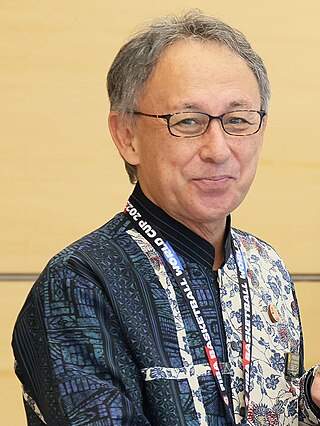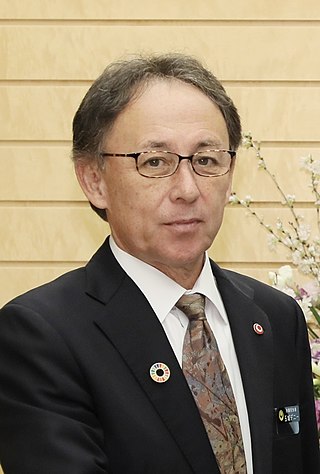
Marine Corps Air Station Futenma or MCAS Futenma is a United States Marine Corps base located in Ginowan, Okinawa, Japan, 5 NM northeast of Naha, on the island of Okinawa. It is home to approximately 3,000 Marines of the 1st Marine Aircraft Wing and other units, and has been a U.S. military airbase since the defeat of the Japanese Imperial Army in the Battle of Okinawa in 1945. Marine Corps pilots and aircrew are assigned to the base for training and providing air support to other land and sea-based Marines in Okinawa and throughout the Asia-Pacific region. MCAS Futenma is part of the Marine Corps Installations Pacific command.

Camp Schwab is a United States Marine Corps camp located in northeastern Okinawa Prefecture, Japan, that is currently home to the 4th Marine Regiment and other elements of the 28,000 American servicemen based on the island. The Camp was dedicated in 1959 in honor of Medal of Honor recipient Albert E. Schwab who was killed in action during the Battle of Okinawa.

Hirokazu Nakaima is a Japanese bureaucrat, business leader, and politician. He was elected governor of Okinawa Prefecture in 2006.

The Ryukyu independence movement or the Republic of the Ryukyus is a political movement advocating for the independence of the Ryukyu Islands from Japan.

The 1995 Okinawa rape incident occurred on September 4, 1995, when three U.S. servicemen, U.S. Navy Seaman Marcus Gill and U.S. Marines Rodrico Harp and Kendrick Ledet, all serving at Camp Hansen on Okinawa, rented a van and kidnapped a 12-year-old Okinawan girl. They beat her, duct-taped her eyes and mouth shut, and bound her hands. Gill and Harp then raped her, while Ledet claimed he only pretended to do so due to fear of Gill. The offenders were tried and convicted in Japanese court by Japanese law, in accordance with the U.S.–Japan Status of Forces Agreement. The families of the defendants initially claimed that Japanese officials had racially discriminated against the men because they were all African American and coerced confessions from them, but later retracted the claims. The incident led to further debate over the continued presence of U.S. forces in Japan among Okinawans.
Chobin Zukeran is the mayor of Nanjō, Okinawa and a former member of the House of Representatives of Japan, representing Okinawa 4th district. He was elected in the 2009 Japanese general election. He is an outspoken proponent of the removal of American bases from Okinawa.
The Okinawa at-large district is a constituency of the House of Councillors in the Diet of Japan. It consists of the entire prefecture of Okinawa and was created in 1970 following the agreement between US president Richard Nixon and prime minister Eisaku Satō on restoration of Japanese sovereignty over the Ryūkyū islands. Okinawa is represented by two Councillors electing one every three years.

The 11th Okinawa gubernatorial election was held on November 28, 2010. The official campaign start began November 11. The 2010 election garnered national attention mostly for the dispute between the central government and local communities in Okinawa over the planned relocation of Marine Corps Air Station Futenma from Ginowan to Henoko in Nago that had also contributed to the resignation of prime minister Yukio Hatoyama in June 2010.

Denny Tamaki is a Japanese politician and the current Governor of Okinawa Prefecture since August 2018.

Over the last five decades there have been various plans for the relocation of Marine Corps Air Station Futenma, a United States Marine Corps base located within the urban area of Ginowan City in Okinawa, Japan. The current proposal for a new site in Henoko Bay, Nago, has faced opposition from Okinawans and the local government who wish for the new base to be located off the island altogether.

Takeshi Onaga was a Japanese politician and the seventh Governor of Okinawa Prefecture from 2014 to 2018.

Okinawa 1st district is a constituency of the House of Representatives in the Diet of Japan. It is located in Okinawa Prefecture and encompasses the city of Naha and parts of Shimajiri District. As of 2016, 270,872 eligible voters were registered in the district.

The 2018 Okinawa gubernatorial election was held on 30 September 2018 to elect the next governor of Okinawa. As there are no term limits in Japan, incumbent Governor Takeshi Onaga was eligible for re-election before his death in August 2018. The election was originally scheduled to be held on 9 December 2018, but this was brought forward after Onaga's untimely death. Onaga's deputy, Kiichiro Jahana temporarily assumed his post for three days until being replaced as interim governor by Moritake Tomikawa. This was the first gubernatorial election in Okinawa since the voting age was lowered to 18.

Okinawa 2nd district is a constituency of the House of Representatives in the Diet of Japan. It is located in Okinawa Prefecture and encompasses the cities of Urasoe and Ginowan, and Nakagami District. As of 2016, 288,070 eligible voters were registered in the district.

Okinawa 3rd district is a constituency of the House of Representatives in the Diet of Japan. It is located in Okinawa Prefecture and encompasses the cities of Nago, Okinawa, Uruma, Kunigami District and parts of Shimajiri District. As of 2016, 312,171 eligible voters were registered in the district.

Okinawa 4th district is a constituency of the House of Representatives in the Diet of Japan. It is located in Okinawa Prefecture and encompasses the cities of Miyakojima, Ishigaki, Itoman, Tomigusuku, Nanjō, the village of Tarama, Yaeyama District and parts of Shimajiri District. The district was formed after the 2002 national electoral district review assigned Okinawa an extra district. Constituency cities and towns in the 1st and 2nd district were reassigned to form the 4th district. As of 2016, 286,832 eligible voters were registered in the district.

Kiichiro Jahana is a Japanese politician. He is the vice governor of Okinawa Prefecture and took over the interim governorship for a few days.
A referendum was held in Okinawa Prefecture on 24 February 2019. The referendum asked whether voters approved or opposed the landfill work at Henoko Bay for the construction of a new United States Marine Corps base. This is the second prefecture-wide referendum in Okinawa, the first being the 1996 referendum on the reduction of US military presence. Governor Denny Tamaki announced the referendum in November 2018, fulfilling his manifesto promise from his successful campaign for governor.

The main island of Okinawa accounts for 0.6% of Japan's land mass, though about 75% of United States forces in Japan are stationed in the Okinawa prefecture, encompassing about 18% of the main island of Okinawa. Following the ratification of the revised U.S.-Japan Security Treaty in 1960, massive protests of US military presence in Okinawa followed across Japan with an estimated 30 million Japanese citizens participating, known in Japan as the Anpo protest movement. With such a strong focus of United States Forces Japan in Okinawa, residents face economic problems of the highest unemployment in Japan as well as struggle for investment from outside businesses. Immense public opposition in Okinawa is still met with difficulty to create change for Okinawan citizens, while 25,000 American troops remain in Okinawa.

The 2022 Okinawa gubernatorial election was held on 11 September 2022 to elect the next governor of Okinawa. In the election, incumbent Governor Denny Tamaki who was backed by the Constitutional Democratic Party of Japan and some smaller parties ran against Atsushi Sakima who was supported by the Liberal Democratic Party and Komeito. Mikio Shimoji ran against both candidates as a third option. The potential relocation of the Naval Base Okinawa was, again, an important topic in the debate. Over 70% of voters in Okinawa opposed the relocation in the 2019 Okinawan referendum. Tamaki supported the complete removal of the base, while Sakima supported relocating it. Denny Tamaki won with 51.7% of the vote against Sakima and Mikio Shimoji.











